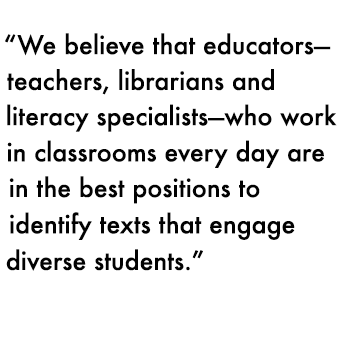![]()
 Emily Chiariello is a Teaching and Learning Specialist with Teaching Tolerance. She has 15 years’ experience as a classroom teacher, professional development and curriculum designer in public, charter and alternative school settings, as well as with non-profit organizations. She holds a master’s degree in philosophy and social policy and is certified in secondary social studies.
Emily Chiariello is a Teaching and Learning Specialist with Teaching Tolerance. She has 15 years’ experience as a classroom teacher, professional development and curriculum designer in public, charter and alternative school settings, as well as with non-profit organizations. She holds a master’s degree in philosophy and social policy and is certified in secondary social studies.
Here she discusses Teaching Tolerance’s new curriculum tool, “Project Appendix D,” that empowers educators to identify texts that both meet the demands of the Common Core Standards and reflect the world in which our students live. This blog post was originally posted at the Teaching Tolerance blog.
by Emily Chiariello
Does the Common Core limit what texts teachers can use? While many people think so, we don’t. Teaching Tolerance believes it is possible—and important—to choose texts that are both rigorous and relevant. Read on to learn about a new approach to text selection: Appendix D: A Tool for Selecting Diverse Texts. This exciting project goes beyond the resources offered in Appendices A and B and offers a new world of possibilities within literacy instruction.
Appendices A and B
Teachers are expected—per the CCSS’s Appendix A—to select more complex texts, teach more nonfiction and ask more text-dependent questions. But do they feel less empowered to choose readings about social justice or to locate texts that reflect the identities and histories of their students and communities? We’re concerned the answer is yes. We know that teachers want texts that mirror their students’ lives. And to achieve equitable outcomes, the Common Core must be implemented in culturally responsive ways that address social emotional learning as well as academic goals. Yet, this kind of implementation is not happening in most districts.
At first glance, one might think that the “Reader and Task” portion of the text selection model in Appendix A makes room for culturally responsive instructional decisions. Instead, there’s only a brief and bland mention of “reader variables”—motivation, knowledge and experiences—ultimately eclipsed by the other two measures: hard Lexile scores (quantitative) and subjective interpretations of meaning and purpose (qualitative).
 And then there’s the stark imprint of privilege found in the gaps and silences of Appendix B, a list of “text exemplars” that meet the aforementioned approach to text complexity, quality and range. Too many publishers—and districts, too—have interpreted the text exemplars listed in Appendix B as a required reading list.
And then there’s the stark imprint of privilege found in the gaps and silences of Appendix B, a list of “text exemplars” that meet the aforementioned approach to text complexity, quality and range. Too many publishers—and districts, too—have interpreted the text exemplars listed in Appendix B as a required reading list.
Woefully few examples of cultural relevance can be found in “Common Core-aligned” materials and trainings, including Appendix B. Jane M. Gangi, professor of education at Mount Saint Mary College, has analyzed Appendix B and found that, of the 171 texts recommended for children in K-5, only 18 are by authors of color, and few reflect the lives of children of color and children in poverty.
Appendix D
We believe that educators—teachers, librarians and literacy specialists—who work in classrooms every day are in the best positions to identify texts that engage diverse students.
That’s why we’re excited to share our new project: Appendix D: A Tool for Selecting Diverse Texts. Traditionally, tools that support text selection have focused on quantitative and qualitative measures only. But Appendix D promotes a multi-dimensional approach to text selection that prioritizes complexity as well as critical literacy and cultural responsiveness.
Appendix D empowers educators to rely on their knowledge of their students, rather than a prepopulated lists of titles, when selecting texts. The tool walks users through four distinct—but interconnected—text-selection considerations: complexity, diversity and representation, critical literacy, and reader and task. And it’s an editable PDF, allowing folks to document, save and share their text-selection process. (Be sure to download to unlock the editing capabilities.)
So, why a tool and not a list? There are commendable lists out there. Gangi and the Collaborative for Equity Literacy Learning (CELL) assembled an alternative list of multicultural titles, but they are not leveled for teachers to assess text complexity. Others, like publishers LEE & LOW, work to bring more diversity and representation into classroom libraries, and to the task of text selection. However, none of the lists we’ve investigated encompass texts that are both culturally relevant and meet the Common Core’s requirements for complexity. And, unless it is dynamic, any list of diverse books is only as diverse as the person—or people—who made it.
We hope the TT community will use Appendix D to help us grow a dynamic and diverse list of texts based on the four considerations and on the diverse needs of our students. We’ve started with the titles currently found in Perspectives for a Diverse America, our new anti-bias curriculum. In the months to come, as you use the Appendix D tool in your own practice, think of which complex, culturally relevant titles you think your fellow social justice educators would want to know about—and be on the lookout for an invitation to submit your texts to the ever-growing, ever-changing TT community list!
Paulo Freire wrote that, when we read words, we read the world. Don’t we owe it to our students to consider them when choosing those words?









